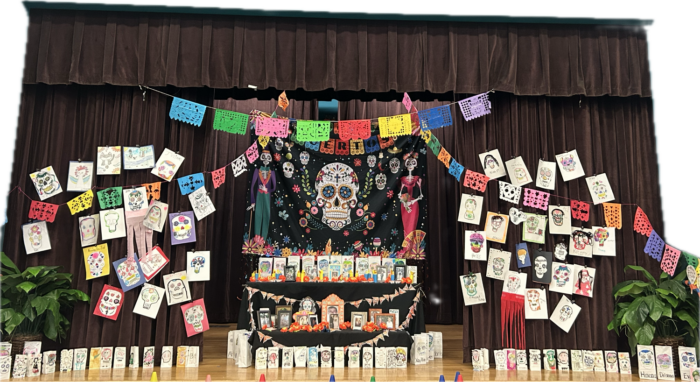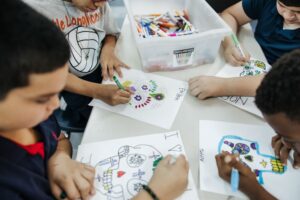When the University of Texas first applied to have an elementary charter school over 20 years ago, the original charter stated that all students as early as Kindergarten would learn Spanish as a second language at the school. The program has evolved from a part-time teacher role to a full-time course that extends all the way from PK – 5th grade as part of UT Elementary’s Margin of Excellence Programs. Research shows that acquiring second-language skills at a young age yields higher cognitive and learning skills, more creative problem-solving, increased empathy, and higher overall academic success. Over 300 students participate in the UT Elementary Spanish Language Arts and Culture program each year, taught by the full-time, National Board-Certified Spanish teacher, Ms. Thelma Herrera.
According to Ms. Herrera, “Students learn authentic vocabulary and songs from people and topics such as “diez y seis de septiembre, Hispanic Heritage month, Dia de los Muertos, and other seasonal traditions. This allows [them] to think about what is happening in other parts of the world, beyond their community. They learn the difference between what national and international mean, and what it means when we talk about and appreciate our country.”
Although some students learn Spanish at home, others are new to the language. Ms. Herrera’s class allows newer speakers to learn from native speakers and vice versa. For instance, Herrera recalls a story of an experienced Spanish-speaker learning that “veinte” (the Spanish word for 20) starts with the letter “v” instead of “b.” “They are learning the phonetics of the language. They are now able to read and correct themselves from misunderstandings,” she said.
This is my first-year learning Spanish. My name is Ace and I’m new to the school. We do crafts and google slides about cultural like Father Hidalgo. I’m learning how to speak Spanish like numbers and songs. I try using Spanish at home. I say to my cousins, “How was your verano?” – Ace, 4th grade
Additionally, through singing, students can quickly identify cognates – word parts that are the same in both English and Spanish – such as months of the year (February / Febrero, March / Marzo, and April / Abril). This helps them learn new vocabulary. “You can almost see how little lightbulbs go off in their head,” said Herrera proudly.
I have learned more vocabulary during morning meeting. I enjoyed making projects with the songs we are leaning by drawing words that match the vocabulary. I enjoyed making Google slides about the persons in history who changed things in Mexico and how our culture started. I’m able to talk to my grandma more because I understand more vocabulary. – Ziba, 4th grade (native speaker)
The Spanish program is multi-faceted, as students gain experience from hands-on, project-based activities that involve various modes of learning to engage students: singing songs, putting on plays, designing their own vocabulary board games, and even creating digital presentations that are shared with the entire school community. Ms. Herrera said, “The students are finding the joy and love for the language on their own, through exploration.”
My favorite things to learn in Spanish are singing songs like “Feliz Navidad” by Jóse Feliciano because he got in the top 20 song for Christmas in this century. After school, when my parents or grandparents pick me up I say, “Hola”. In the morning, when I wake up, I say, “Buenos Días” to my mom and dad. Hilario, 4th grade





